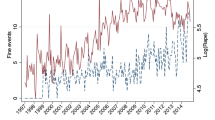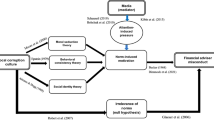Abstract
The use of cheques has been declining in the European Union (EU), along increased integration in the payments field. This trend is not uniform across the EU, and some countries have implemented policies to discourage the use of cheques due to its considerable social costs and risks. This paper provides a cross-country analysis for the period 2000–2012 of the determinants of cheque usage, measured both as per capita number and share of payments. Special attention is given to the effects of the application of fees in a framework where unfunded cheques are considered as an autonomous type of crime in some EU countries. Our results suggest that the existence of fees influences negatively cheque usage, even when there are legal elements that increase its security.


Similar content being viewed by others
Notes
SEPA is a project that aims to harmonise retail payments in euro by enabling individuals, firms and public administrations to make and receive cashless payments throughout the Member States of the EU and Iceland, Liechtenstein, Monaco, Norway, Switzerland and San Marino using just one bank account located in any of these countries and a single set of payment instruments (credit transfers, direct debits and cards). For more information see, for example, Virtanen (2014).
The share was computed considering the relative importance of the number of payments with cheques on the total number of payments made with cheques, credit transfers, direct debits and cards.
According to the Bank for International Settlements, in 2014, the relative importance of cheques (in volume) was 37.5 % in the United States of America and 13.1 % in France.
For a detailed definition of each one of these non-cash payment instruments see Kokkola (2010).
The analysis is focused on non-cash payment instruments.
This type of cheque could be used in different countries.
In some cases we obtained the information on the website of the Central Banks and/or of commercial banks. In the collection of the information we requested data for the period under analysis. Since not all time information was provided by Central Banks, we considered it as time-invariant in the model.
One of the elements that might affect the use of payment instruments is price. However, at cross-country level there is no information available on this factor. Humphrey et al. (1996) computed a proxy for the price of payment instruments used on their analysis that consisted on the amount of fees, but concluded that the influence was very modest. Our variable differs from the proxy proposed by Humphrey et al. (1996) since it captures the impact of the existence of fees, not the effect of their amount.
In order to capture changes in cheque usage due to other factors besides those included as explanatory variables or due to the simple passage of time, we also considered models including a linear time trend. However, because this variable was not significant and the coefficients of the other variables remained very similar, we decided to present more parsimonious models, which do not include the time trend.
Note that, according to Gourieroux et al. (1984), the Poisson estimator with robust standard errors is consistent, even under misspecification of the Poisson distribution, as long as the mean is correctly specified.
Note that this is essentially a t test for the significance of the predicted outcome obtained under the model of the alternative hypothesis, which is included as an additional regressor in the model under the null hypothesis.
Note that there is evidence that the J test of Davidson and MacKinnon (1981) tends to over-reject the null hypothesis, namely when the model under the null presents a poor fit (Godfrey and Pesaran 1983). In this framework, the fact that our exponential model was not rejected is very encouraging and reinforces the choice of this model as the best description for the number of per capita payments with cheques.
The authors used a proxy for the prices of the various payment instruments due to unavailability of data for all countries included in the model.
References
APCA (2011) The role of cheques in an evolving system. Sydney
Boeschoten W (1998) Cash management, payment patterns and the demand for money. De Economist 146:117–142
Bolt W, Humphrey D, Uittenbogaard R (2008) Transaction pricing and the adoption of electronic payments: a cross-country comparison. Int J Cent Bank 4:89–123
Bordo MD (2014) Tales from the Bretton woods. Open Econ Rev 25:981–991. doi:10.1007/s11079-014-9326-8
Borzekowski R, Kiser EK (2008) The choice at the checkout: quantifying demand across payment instruments. Int J Ind Organ 26:889–902
Cameron, AC, Trivedi, PK (2009) Microeconometrics using stata. A Stata Press Publication, Texas
CBI (2014) Cheque Survey 2014. Dublin
Davidson R, MacKinnon JG (1981) Several tests for model specification in the presence of alternative hypotheses. Econometrica 49:781–793. doi:10.2307/1911522
Deungoue S (2008) Will we pay in the same way? Eur. J Financ 14:49–67. doi:10.1080/13518470701773692
Dinger V, Steinkamp S, Westermann F (2014) The tragedy of the commons and inflation bias in the euro area. Open Econ Rev 25:71–91. doi:10.1007/s11079-013-9300-x
ECB (2013) The Single Euro Payments Area (SEPA): an integrated retail payments market. Frankfurt am Main
ECB (2015) Financial Integration in Europe. Frankfurt am Main
ECB (2016a) Making Europe’s financial market infrastructure a bulwark of financial stability (speaking points). 7
ECB (2016b) Shaping the future of Europe’s financial market infrastructure. 3
Fratianni M, Pattison J (2001) Review essay: the Bank for International Settlements: an assessment of its role in international monetary and financial policy coordination. Open Econ Rev 12:197. doi:10.1023/A:1008336530686
Godfrey LG, Pesaran MH (1983) Tests of non-nested regression models. J Econom 21:133–154. doi:10.1016/0304-4076(83)90123-9
Gourieroux C, Monfort A, Trognon A (1984) Pseudo maximum likelihood methods: applications to Poisson models. Econometrica 52:701–720. doi:10.2307/1913472
Guariglia A, Loke YJ (2004) What determines the value and volume of noncash transactions? Evidence from a panel of European and north American countries. Appl Econ 36:291–303
Hausman JA (1978) Specification tests in econometrics. Econometrica 46:1251–1271
Hausman JA, Taylor WE (1981) Panel data and unobservable individual effects. Econometrica 49:1377–1398
Hayashi F, Klee E (2003) Technology adoption and consumer payments: evidence from survey data. Rev Netw Econ 2:175–190
Humphrey DB (2010) Retail payments: new contributions, empirical results, and unanswered questions. J Bank Financ 34:1729–1737
Humphrey DB, Pulley LB, Vesala JM (1996) Cash, paper, and electronic payments: a cross-country analysis. J Money Credit Bank 28:914–939
Humphrey DB, Kim M, Vale B (2001) Realizing the Gains from Electronic Payments: Costs, Pricing, and Payment Choice. J Money, Credit Bank 33:216–234
Klee, E (2006) Families’ use of payment instruments during a decade of change in the U.S. payment system. Washington
Klee E (2008) How people pay: evidence from grocery store data. J Monet Econ 55:526–541
Kokkola, T (ed) (2010) The payment system. European Central Bank, Frankfurt am Main
Koulayev, S, Rysman, M, Schuh, S, Stavins, J (2012) Explaining adoption and use of payment instruments by U.S. consumers. Federal Reserve Bank of Boston 12:1–40
Martikainen E, Schmiedel H, Takalo T (2015) Convergence of European retail payments. J Bank Financ 50:81–91
Nyberg, L (2008) Cash and payments - what lies ahead? Stockholm: Sveriges Riksbank, 6
Papke LE, Wooldridge JM (1996) Econometric methods for fractional response variables with application to 401 (K) plan participation rates. J Appl Econom 11:619–632
Quinn, S, Roberds, W (2008) The Evolution of the Check as a Means of Payment: A Historical Survey. Federal Reserve Bank of Atlanta Economic Review 93:1–28
Ramalho EA, Ramalho JJS (2016) Moment-based estimation of nonlinear regression models with boundary outcomes and endogeneity, with applications to nonnegative and fractional responses. Econom Rev. doi:10.1080/07474938.2014.976531
Ramalho EA, Ramalho JJS, Murteira JMR (2011) Alternative estimating and testing empirical strategies for fractional regression models. J Econ Surv 25:19–68
Schmiedel, H, Kostova, G, Ruttenberg, W (2012) The social and private costs of retail payment instruments: A European perspective. Frankfurt am Main
Schuh S, Stavins J (2010) Why are (some) consumers (finally) writing fewer checks? The role of payment characteristics. J Bank Financ 34:1745–1758
Schuh S, Stavins J (2013) How Consumers Pay: Adoption and Use of Payments. Account Financ Res 2:1–21
Stavins J (2001) Effect of consumer characteristics on the use of payment instruments. New Engl. Econ Rev:19–31
Virtanen, J (2014) The single euro payments area: characteristics, realization and future prospect. Helsinki: Bank of Finland – Financial stability and statistics
Wooldridge, JM (2002) Econometric analysis of cross section and panel data. The MIT Press, London
Acknowledgments
The opinions expressed in the article are those of the authors and do not necessarily coincide with those of the Banco de Portugal or the Eurosystem. Any errors and omissions are the sole responsibility of the authors. The authors gratefully acknowledge the suggestions of the Editor and an anonymous referee. The assistance of Rui Pimentel in collecting information on the legal factors considered in the analysis, as well as the useful comments of Joaquim Ramalho are also thankfully acknowledged. Financial support from Fundação para a Ciência e a Tecnologia and FEDER/COMPETE (grants PTDC/EGEECO/119148/2010 and UID/ECO/04007/2013) is also gratefully acknowledged.
Author information
Authors and Affiliations
Corresponding author
Appendix
Appendix
Rights and permissions
About this article
Cite this article
Silva, V.G., Ramalho, E.A. & Vieira, C.R. The Use of Cheques in the European Union: A Cross-Country Analysis. Open Econ Rev 28, 581–602 (2017). https://doi.org/10.1007/s11079-016-9412-1
Published:
Issue Date:
DOI: https://doi.org/10.1007/s11079-016-9412-1




